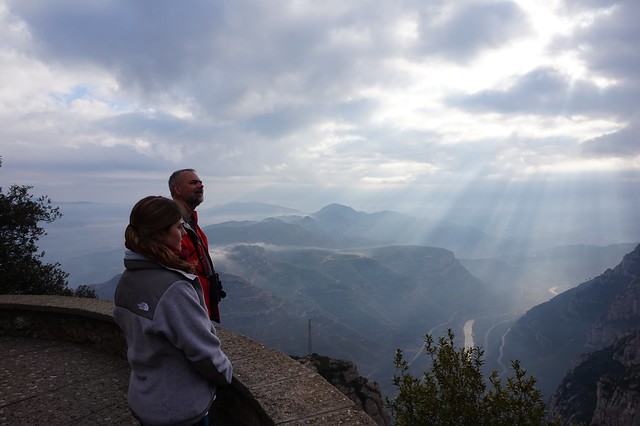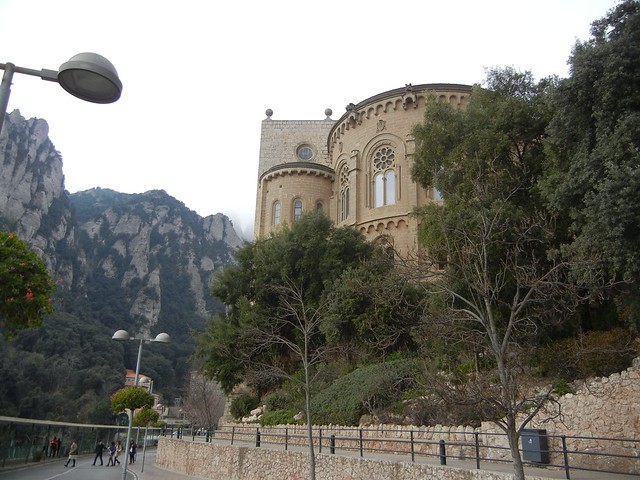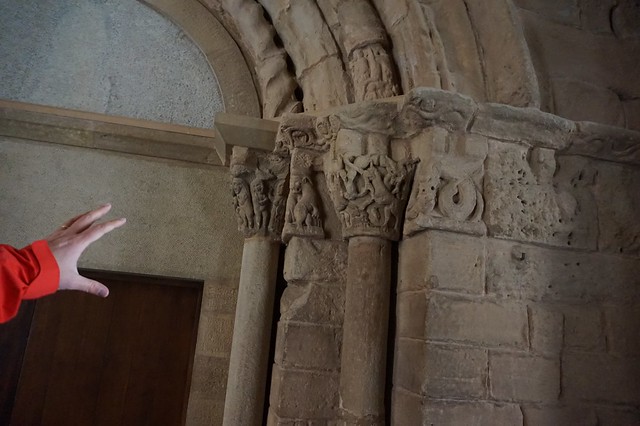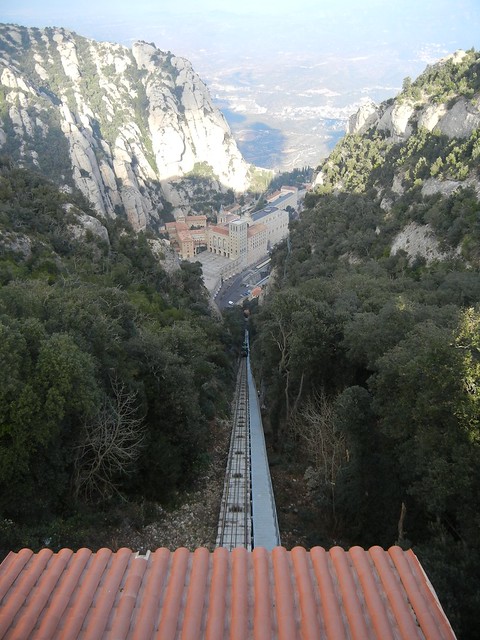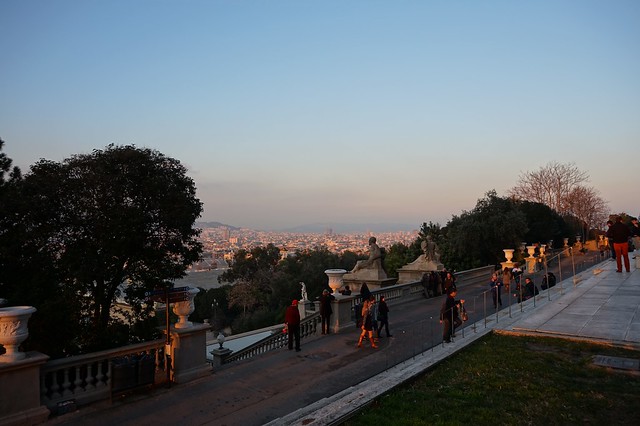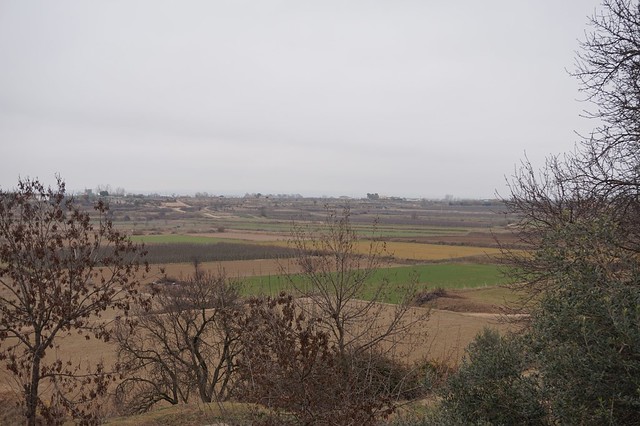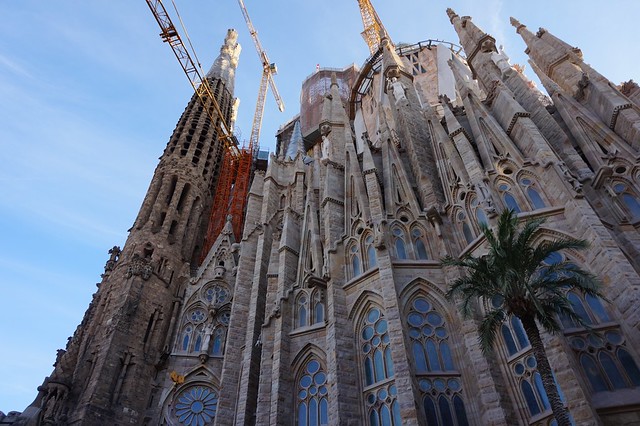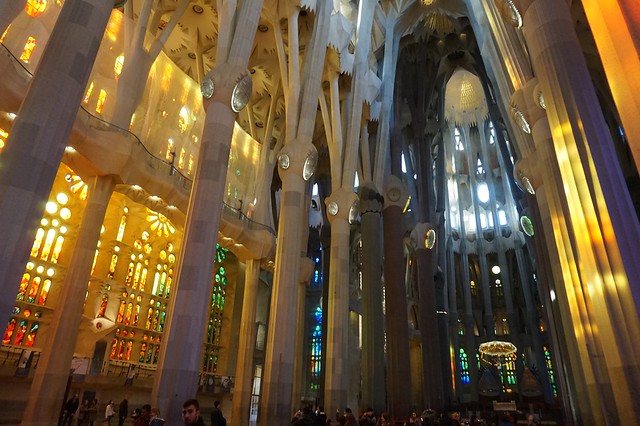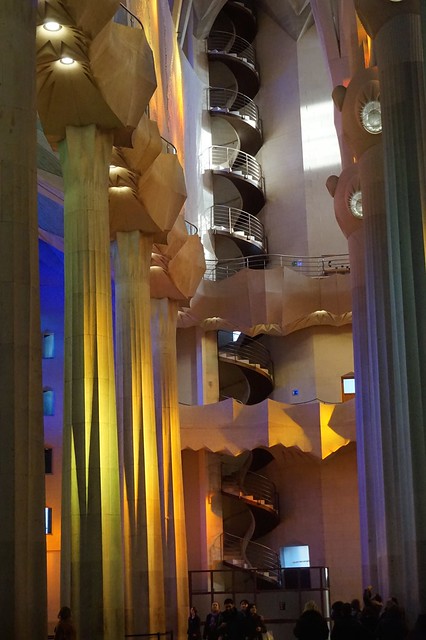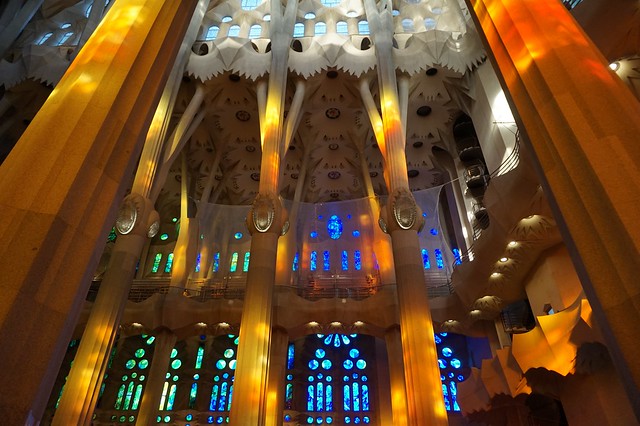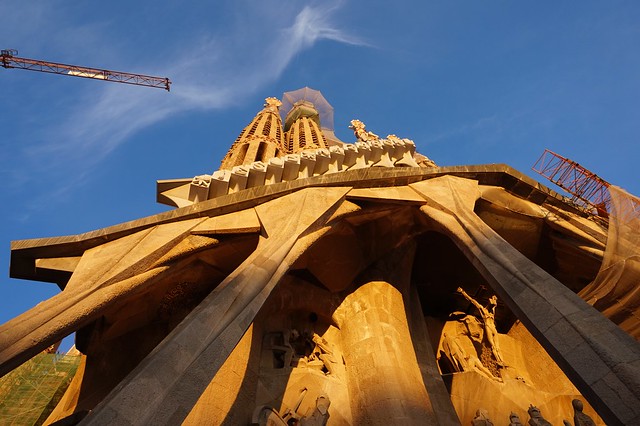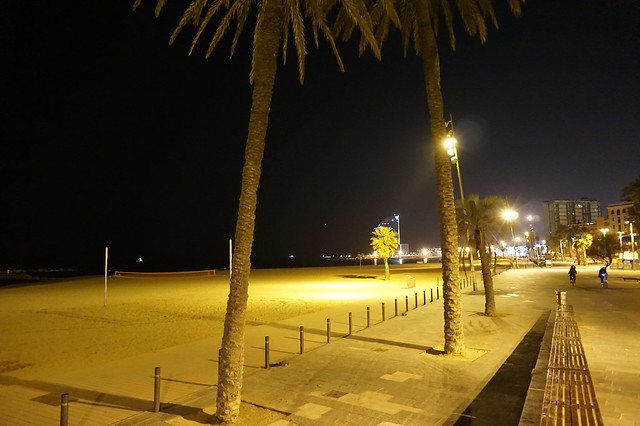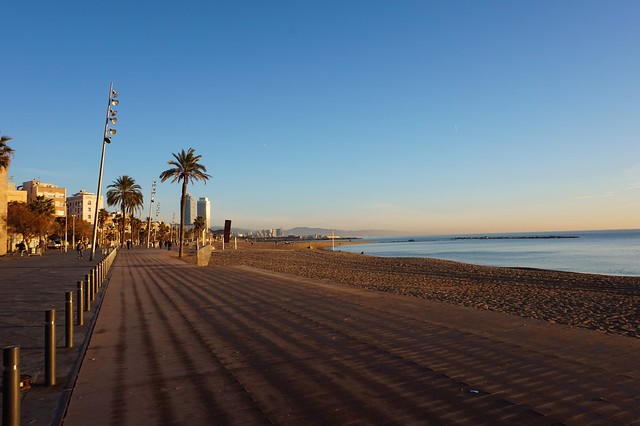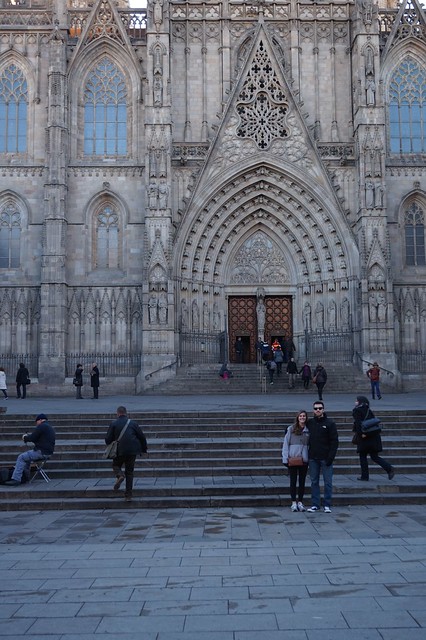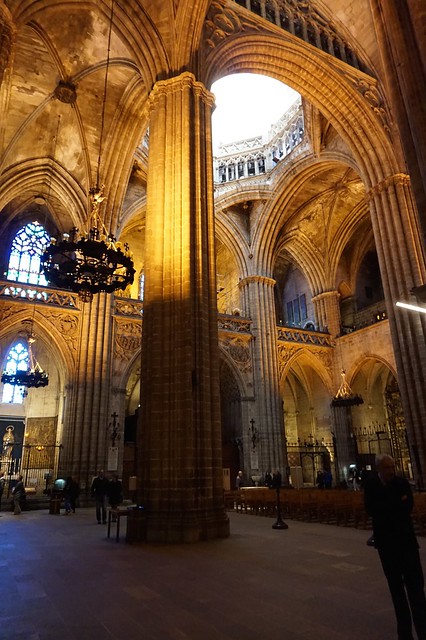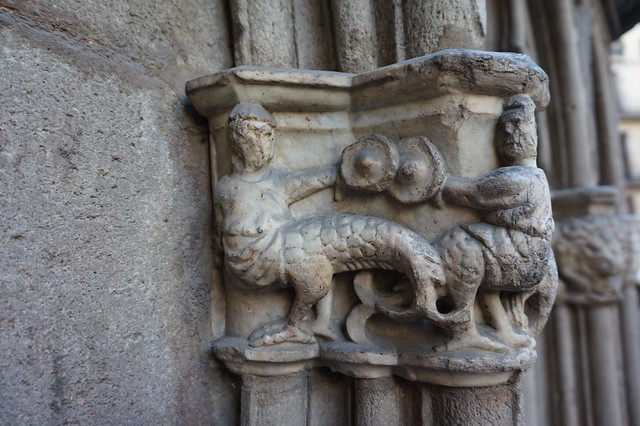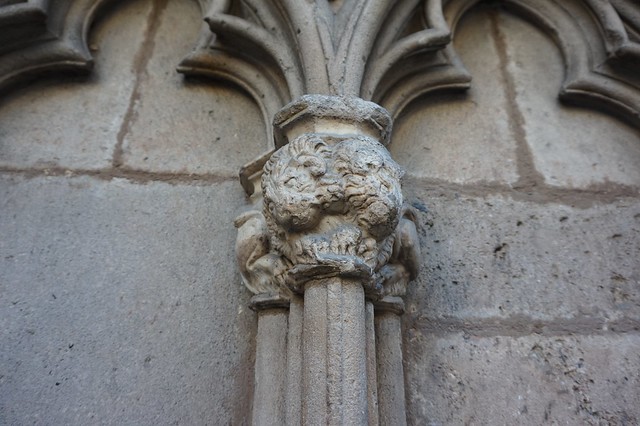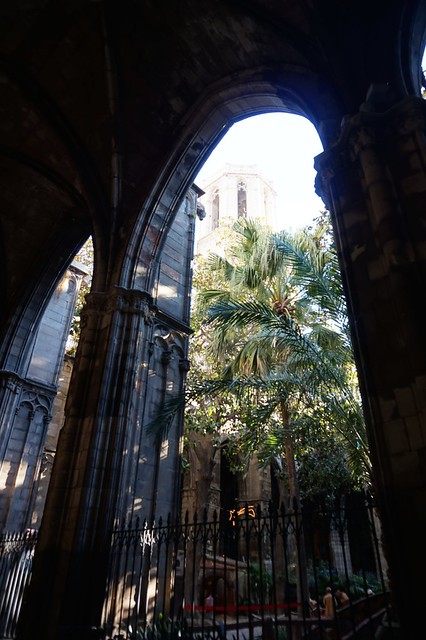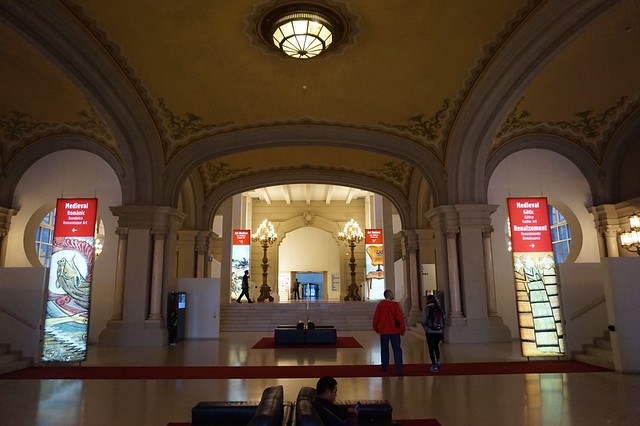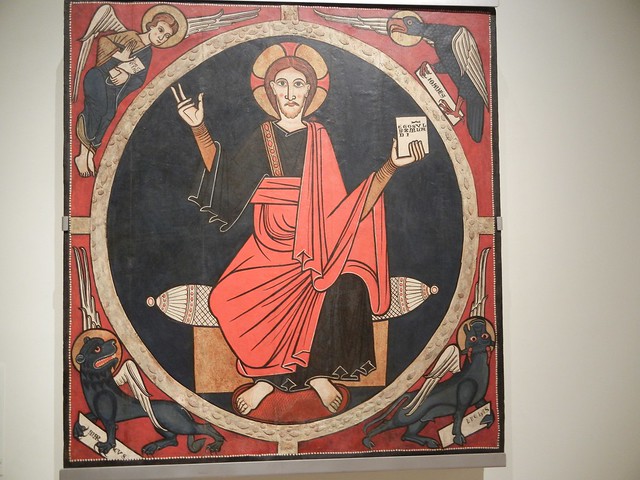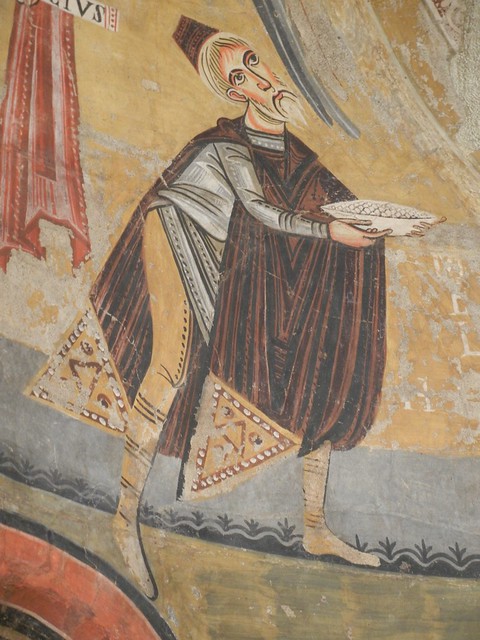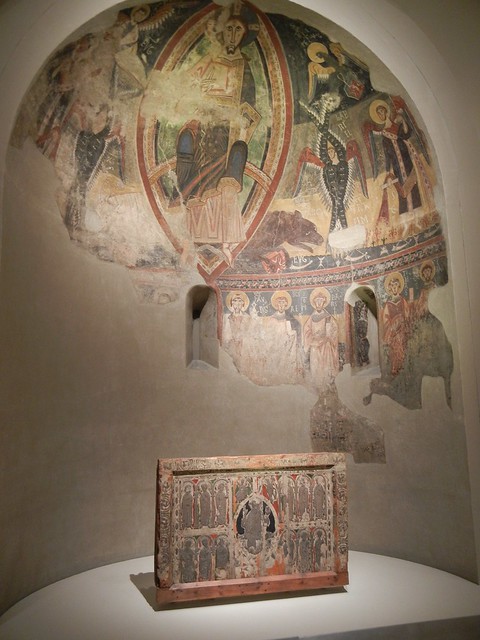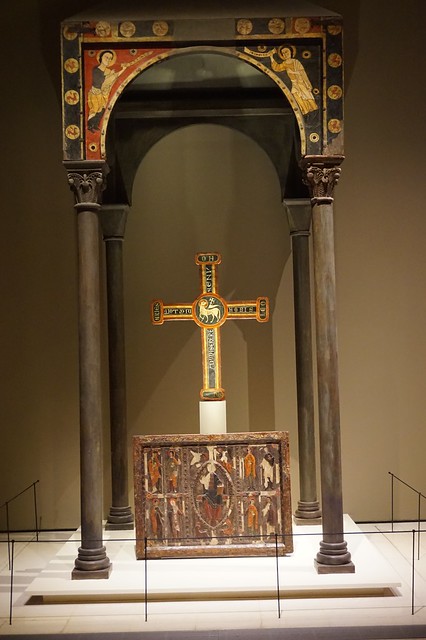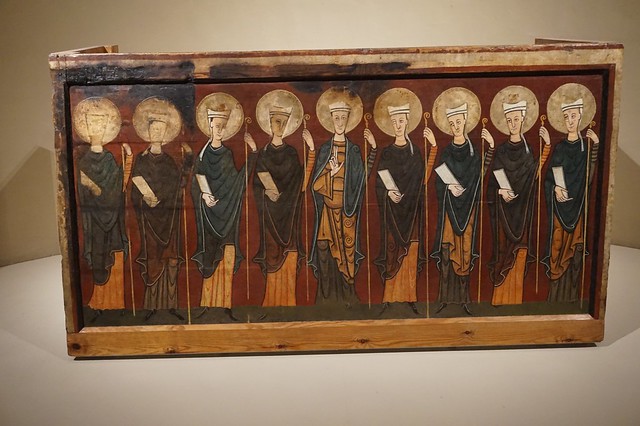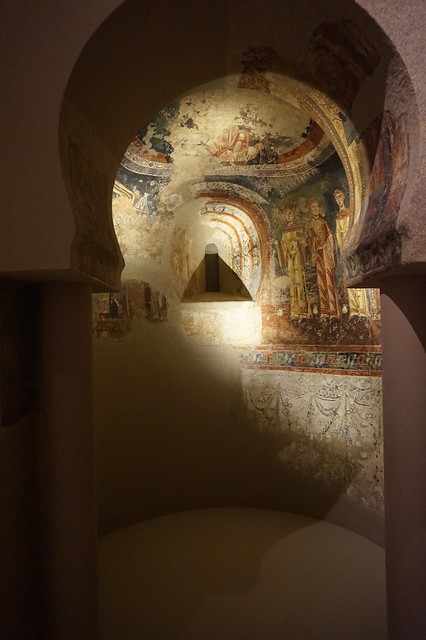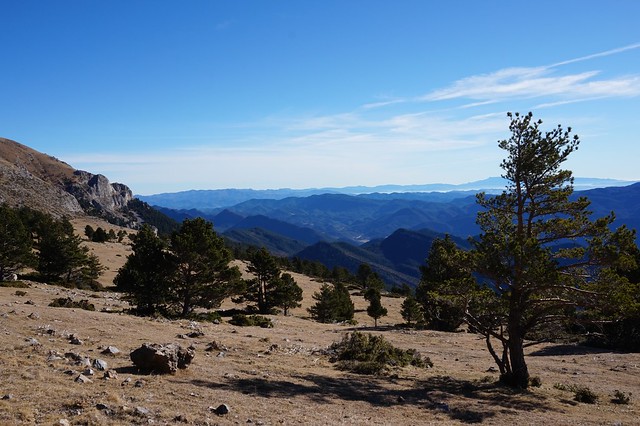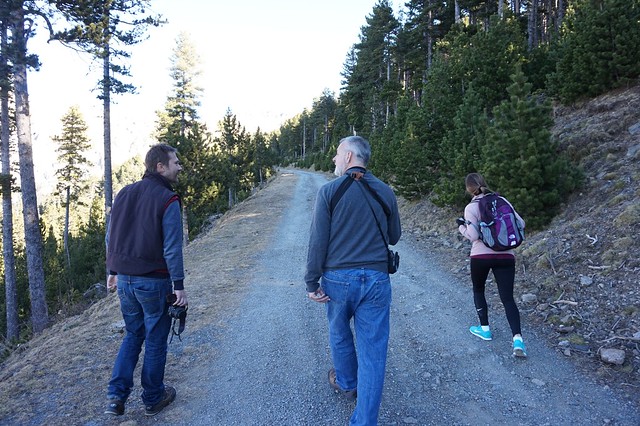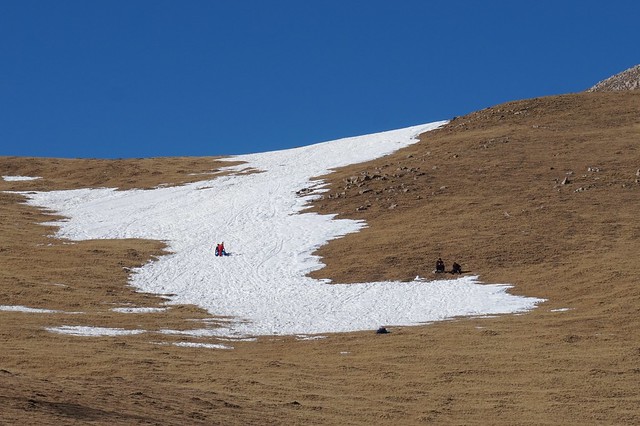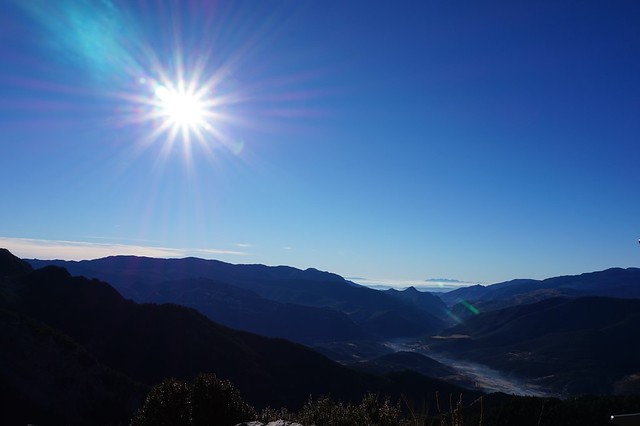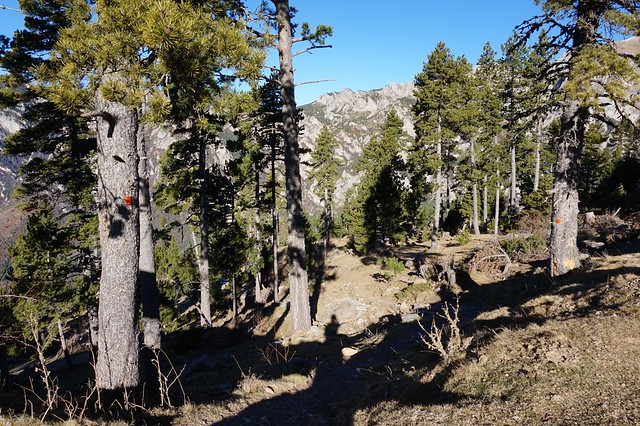We decided to go not quite so far afield the next day, and settled on the stunning mountain of Montserrat as our destination.
Getting there was half the fun indeed. The drive was easy and fast, and we transferred to the mountain train to take us up to the monastery complex.
The cliffs are high enough and massive enough to create their own weather: it had been warm and bright down below, but much of the morning was damp and chilly — never rainy, never cold — as we wandered the streets and admired the buildings raised over the centuries.
There are a few medieval remnants, such as this fragment of the Gothic cloister
and this strikingly flamboyant door:
The basilica itself was rebuilt at the end of the nineteenth century, incorporating some Gothic elements and a few Romanesque remains, most of the latter pretty badly weathered.
Long an important station on the route to Compostela, Montserrat still draws large numbers of pilgrims eager to see the Romanesque “black” Virgin and Christ Child, which perches high in a gallery above the choir. The line was long, but it was worth getting to see what is essentially the national statue of Catalonia.
We had lunch, then, as skies turned blue, got on the funicular to be dragged farther up the steep mountainside.
It was pretty breathtaking up there, the sparsely vegetated rocks and cliffs perfect for all sorts of alpine birds come spring.
An early January day didn’t have much appeal for the birds, unfortunately, though there were plenty of robins and black redstarts, as partout. We’d meant to check out the little cemetery behind the train station on our way back down, but I decided it might be more fun to spend the last couple of hours of daylight back in sunny Barcelona. We wound up taking a nice walk atop Montjuic, looking down on the city as the light turned soft and dim.
The next morning, refreshed and well breakfasted, we decided to drive west. It was a pretty morning in Barcelona, but not far out of town we ran into fog, then freezing temperatures, then a bit of mist, and more fog. We pushed on anyway, hoping the weather would clear.
It didn’t.
We left the highway before Lleida to explore some promising-looking agricultural areas. Once we were out of the traffic and driving dirt roads through the countryside, the weather seemed suddenly less grim: it was no different, but without trucks bearing down on us from both sides, we could enjoy the soft light and the wide-open views. There were even a few birds. Little gangs of red-legged partridges emerged from the fog here and there, and impressive flocks of chaffinches and linnets swept from hedgerow to field and back.
It was cold enough that we spent most of the morning in the car, stepping out now and again to confirm that the wind was still biting and the air still damp. Our plans to walk around the lake at Ivars were abruptly canceled when I found that I could hardly stand without shivering. I got no sympathy when I e-mailed home that night to poor Alison in New Jersey’s 8 degrees.
A hot lunch sounded like the better part of discretion, after which we headed back to Barcelona. Fog, freezing temperatures, a bit of mist, and more fog — and then we emerged from it all into another warm, bright, still afternoon, just perfect for a little sightseeing in town.
We hadn’t been to the Sagrada Familia yet, so zipped over there and stood in line for a few minutes to get in. I’d expected irony, preciosity, even a little bit of kitsch, and was bowled over to find the place in fact beautiful and moving.
It wasn’t hard to hear the echo of Santa Maria del Mar in the treatment of the vaults, and I understood, as no photograph could make me understand, how well this church — still a-building thirteen decades after it was begun — fits into the architectural and spiritual history of the city. Even full of tourists (and this in early January), it is a quiet, reflective, inspiring place. See it if you can.
Culturally sated, it was time for dinner.
We met Malte in Barceloneta for an evening stroll and a good meal, then back to the hotel to watch the day’s events replay behind our eyelids.
The drive through the fog had put me off motoring for a while, so the kids and I spent the next day wandering through Barcelona on foot. It’s a big city indeed, but if not for our overpowering need to get out of it to see birds, it would be easy to stay two or three weeks without ever using any mode of transportation but shoe leather.
We started off on the beach in Barceloneta, watching the sun rise and the black-headed gulls wake up.
Then it was on to Barcelona’s Gothic Quarter and, eventually, the city’s fourteenth-century cathedral.
That west front is a bit over the top.
The interior, too, seemed less successful than Santa Maria del Mar, stumpier, less well articulated, more ponderous. There are some pretty capitals outside, though:
And the little cloister was a lot of fun, with palm trees, a large Nativity scene, and a dozen white graylags paddling noisily around on a cistern.
We ended the day up on the Montjuic again, this time, though, with plans for an all-out assault on the National Museum of Catalan Art.
Two hours later, I had to admit that the very first hall — Romanesque wall paintings and (a very little) sculpture — had vanquished me. We’d been warned that it was a big collection and that one really couldn’t just glance, nod, and walk to the next object; sure, sure, I thought.
Well, really.
You begin to get the idea. This is a museum that demands repeated visits (the ticket office knows it, too: one ticket gives you two admissions). I’m going back as soon as I can, armed this time with lunch.
I was exhausted, but not so much as not to enjoy another good dinner, this time on one of the smaller ramblas in the Gothic Quarter. I don’t think I could ever intentionally find the restaurant again — but much of the pleasure of Barcelona, we were discovering, was coming across the things you didn’t know you should be looking for.
It’s unclear how it happened, but the next day was already our last together in Catalonia. Malte met us at the hotel and we headed north as the sun rose to our right; by the time we arrived in Bagà, on the edge of Cadí-Moixeró Natural Park, the bright skies and warm temperatures had, too, and as soon as we left the very helpful visitor center, we’d all begun to shed layers.
The few miles up to the pass of Pal were beautiful, and the weather and the landscape drew us out of the vehicle every few hundred yards to check out a trail or path.
The kind staff at the visitor center had reminded us that the near-absence of snow would mean few birds, but we did run across a single little band of alpine accentors on the roadside near one of the ski shelters, a glimpse of what the road could be like on a more wintry day.
The pass was stunning.
I don’t remember seeing or hearing a single bird up there, but the rocky tundra must be alive in the springtime with wheatears and pipits and who knows what else. On our visit, the little patches of snow had drawn bipeds of another kind, with sleds.
Tempting as it was to join them, we went back downhill a bit to look for birds of prey against the rapidly warming sky.
Our reward was lots of griffon vultures, some of them floating past just beneath us as we sat and soaked up the sunshine. Malte and Sara had seen a lammergeier on their last visit, but we weren’t that lucky; next time!
We continued downhill to Bagà, where we’d been recommended a couple of woodland sites. One of them concealed this lovely little Romanesque chapel:
The surrounding woodlands had singing coal and great tits, and we were surprised to see this pretty flower — the unpleasantly named fetid hellebore — blooming beneath the pines.
The shadows were lengthening, and we had an early morning coming up, so it was back to Barcelona, sorry not to have seen black woodpeckers and lammergeiers this time around but full all the same of what we had experienced on such a fine day.
We hadn’t been having any trouble getting up all week, but when you know that your destination is an outbound flight, it’s doubly tempting to spend some more time with the pillow. But we were up and out right on time, listening to the black redstarts sing in the dark as we walked to pick up the car. No traffic at all meant that we had the vehicle returned and ourselves checked in and securificationalized with plenty of time for one last quick breakfast together. Then Josh and Lizzie were off straight to Newark, me by way of Lisbon. Alison scooped us up as our various flights straggled in, and suddenly our vacation was over.
Good to be home, as always, and looking forward to the next visit to Catalonia. Thanks to Lizzie and Josh and Malte for a great week!

